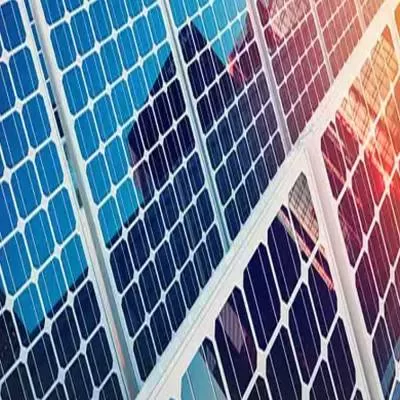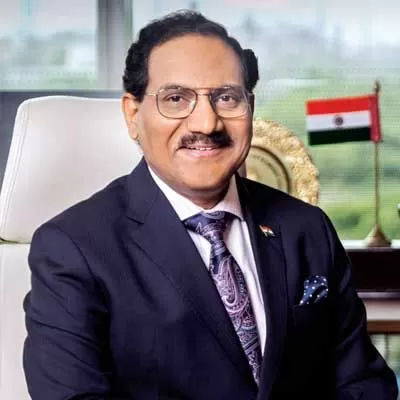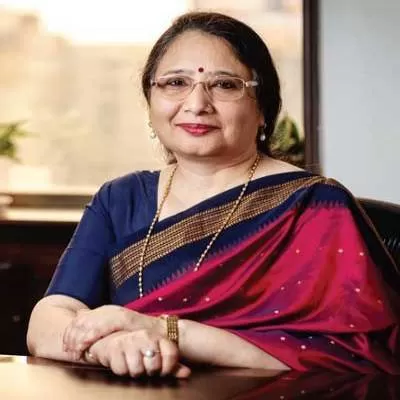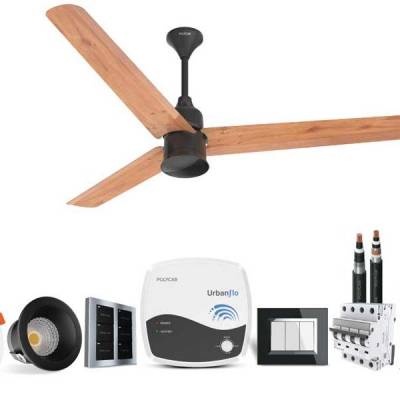- Home
- Infrastructure Energy
- POWER & RENEWABLE ENERGY
- The aim is to stabilise what we have built....
The aim is to stabilise what we have built....
Here’s a crystal clear strategy – literally. City Corporation Ltd, a Pune-based township company and developer of the Amanora Park Town in Pune, recently collaborated with Swarovski, a leading global fashion and lifestyle brand, on its iconic project Gateway Towers 1 in Amanora. With this, Gateway Towers 1 will be the world’s first luxury residential project crystallised by Swarovski. Aniruddha Deshpande, Managing Director, City Corporation Ltd, shares more about this association and the company’s activities in conversation with Shriyal Sethumadhavan.
What is the rationale behind this alliance with Swarovski?
For Gateway Towers 1, our search was on for a partner who would add to the design of the building. Crystals have been existent since ancient times in India and are mentioned in Vastu Shastra as well. Hence, we decided to use them in construction and Swarovski was undoubtedly our first choice. We are certain that the use of crystal in open spaces, common areas and apartments will add a lot of value to the living experience.
You have some other global associations as well...
We have been associated with Singapore-based P&T Consultants Pte Ltd for a long time now. Singaporeans relate more to Indian style, requirements and needs, and P&T has been able to fulfil these requirements. Also, our project in Pune, Future Towers is being designed by Holland-based MVRDV. We selected them because of their experience in social housing. However, with global architects, you need to be very clear and crisp on your plan and requirements. While the younger generation is getting used to this, the older developers are more focused on FSI and hence find it difficult to accept global architecture.
With such a global connection, any plans to build outside India?
No plans as such! If you view the history of the construction business, no one has been successful even pan-country. The issue in India is that our laws are different for every district. Pune itself has three different development plans – a regional plan, the old development plan and the new development plan – and none of them are related to each other. This also increases the difficulty level for project permissions.
The Amanora township is built as per the Maharashtra State Township Policy...
This policy has been introduced to reduce the government’s load on creating infrastructure. So, as a developer, I need to service the township in terms of water, electricity, sewage treatment plant, garbage disposal, security roads, etc, and maintain all of it as well. Basically, it’s a self-managed township.
And how affordable is this for a builder?
Without an infrastructure background, executing this will be impossible for a developer. However, City Corporation has an infrastructure background. Also, we have digitalised systems for the in-house architects and maintenance teams. Water treatment plants are amongst the most sophisticated in the world, hence it becomes easier to maintain. And undoubtedly, you need a lot of investment upfront.
What has your investment been like for the Amanora Township?
We have spent around Rs 240 crore only on infrastructure. Land aggregation itself is very expensive. But if you invest upfront, it will take you five years to create the infrastructure and within another five years you will get the returns. The Amanora Township is being built in phases and will take another seven to eight years. However, the sale value should be approximately Rs 35,000 crore.
What is your target audience?
We have apartments as small as 400 sq ft and as big as 6,000 sq ft. Although we focus more on affordable housing than luxury, catering to both enables us to be associated with good brands, indulge in good tie-ups, adds to a variety of input design, and keeps the aspirational value of the brand higher.
How are your apartments priced?
The starting price is at Rs 4,000 per sq ft. However, the apartments we do with Swarovski will be priced at Rs 10,000 per sq ft.
Are you only aiming at developing townships?
At present, my focus is on townships as this involves creating something new. I was also the promoter director for the Lavasa project and it was so difficult to start with. I was involved in this project for 10 years and realised that in remote areas, creating infrastructure, wherein you need to ensure uninterrupted electricity and water, is very expensive and challenging. This is a problem with all Greenfield projects in these areas. Similarly, even for a project like Amanora, committing to the government and citizens 24 hours water is not that easy. But, I accepted the challenge and it’s been nearly 15 months now that people have been living here without even an hour’s water cut.
You said creating something new...what’s new in Amanora?
Amongst the many new elements in our design, we have built a Temple of Environment. According to the special township policy, you need to build a place to worship within the premises. As India is a multi-religious country, we planned for a pyramid. This has got a lot of positive energy and on its top we have made a tree out of 23 kg of gold. Today, people within the township actually worship it. Also, the UN Environment Programme has registered this as one of the first Temples of Environment in the world.
In terms of technological advancements, what have you adopted in your projects?
We have been using the Mivan formwork technology and in future are also looking at Shera walls, manufactured in Thailand. This is a type of concrete foam that can be injected into the interior and exterior walls. Due to unavailability of masons, high rise plastering is becoming a challenge and hence we require a technique that is more mechanical. We have tested this technology for the past year and it has worked in terms of reducing the cost and increasing air-conditioning efficiency. It is not just far more superior in looks and finish but reduces the weight of the building and is a friendly material during natural calamities like earthquakes, floods, etc.
In terms of growth, what are your expectations from FY12-13? Any expansion plans?
We are a debt-free company; we work on fixed margins and hence it is not very difficult to sustain. Moreover, as and when the township is operational, it will make money for us. We are planning a township in Navi Mumbai as well. But the aim is to first stabilise what we have already built before moving forward.
Qualifications of a ‘special township’ according to the Maharashtra Government
• It must have a continuous land parcel of minimum 100 acre.
• It must make available abundant clean water supply, 24/7.
• It must ensure reliable power infrastructure.
• Sixty per cent of the area shall be used for pure residential area and at least 20 per cent as parks, gardens and playgrounds.
• It must be well-knit by roads ranging from 30 ft to 80 ft.
• Environmentally speaking, a perfect township ensures care of the existing ecological systems, rainwater harvesting systems, and efficient waste management systems.
• It must have schools, hospitals and fire stations on the premises.
• It needs clearances from a multitude of government bodies.
• It offers a 50 per cent waiver benefit on stamp duty.
Aniruddha Deshpande, Managing Director, City Corporation LtdHere’s a crystal clear strategy – literally. City Corporation Ltd, a Pune-based township company and developer of the Amanora Park Town in Pune, recently collaborated with Swarovski, a leading global fashion and lifestyle brand, on its iconic project Gateway Towers 1 in Amanora. With this, Gateway Towers 1 will be the world’s first luxury residential project crystallised by Swarovski. Aniruddha Deshpande, Managing Director, City Corporation Ltd, shares more about this association and the company’s activities in conversation with Shriyal Sethumadhavan.What is the rationale behind this alliance with Swarovski?For Gateway Towers 1, our search was on for a partner who would add to the design of the building. Crystals have been existent since ancient times in India and are mentioned in Vastu Shastra as well. Hence, we decided to use them in construction and Swarovski was undoubtedly our first choice. We are certain that the use of crystal in open spaces, common areas and apartments will add a lot of value to the living experience.You have some other global associations as well...We have been associated with Singapore-based P&T Consultants Pte Ltd for a long time now. Singaporeans relate more to Indian style, requirements and needs, and P&T has been able to fulfil these requirements. Also, our project in Pune, Future Towers is being designed by Holland-based MVRDV. We selected them because of their experience in social housing. However, with global architects, you need to be very clear and crisp on your plan and requirements. While the younger generation is getting used to this, the older developers are more focused on FSI and hence find it difficult to accept global architecture.With such a global connection, any plans to build outside India?No plans as such! If you view the history of the construction business, no one has been successful even pan-country. The issue in India is that our laws are different for every district. Pune itself has three different development plans – a regional plan, the old development plan and the new development plan – and none of them are related to each other. This also increases the difficulty level for project permissions.The Amanora township is built as per the Maharashtra State Township Policy...This policy has been introduced to reduce the government’s load on creating infrastructure. So, as a developer, I need to service the township in terms of water, electricity, sewage treatment plant, garbage disposal, security roads, etc, and maintain all of it as well. Basically, it’s a self-managed township.And how affordable is this for a builder?Without an infrastructure background, executing this will be impossible for a developer. However, City Corporation has an infrastructure background. Also, we have digitalised systems for the in-house architects and maintenance teams. Water treatment plants are amongst the most sophisticated in the world, hence it becomes easier to maintain. And undoubtedly, you need a lot of investment upfront.What has your investment been like for the Amanora Township?We have spent around Rs 240 crore only on infrastructure. Land aggregation itself is very expensive. But if you invest upfront, it will take you five years to create the infrastructure and within another five years you will get the returns. The Amanora Township is being built in phases and will take another seven to eight years. However, the sale value should be approximately Rs 35,000 crore.What is your target audience?We have apartments as small as 400 sq ft and as big as 6,000 sq ft. Although we focus more on affordable housing than luxury, catering to both enables us to be associated with good brands, indulge in good tie-ups, adds to a variety of input design, and keeps the aspirational value of the brand higher.How are your apartments priced?The starting price is at Rs 4,000 per sq ft. However, the apartments we do with Swarovski will be priced at Rs 10,000 per sq ft.Are you only aiming at developing townships?At present, my focus is on townships as this involves creating something new. I was also the promoter director for the Lavasa project and it was so difficult to start with. I was involved in this project for 10 years and realised that in remote areas, creating infrastructure, wherein you need to ensure uninterrupted electricity and water, is very expensive and challenging. This is a problem with all Greenfield projects in these areas. Similarly, even for a project like Amanora, committing to the government and citizens 24 hours water is not that easy. But, I accepted the challenge and it’s been nearly 15 months now that people have been living here without even an hour’s water cut.You said creating something new...what’s new in Amanora?Amongst the many new elements in our design, we have built a Temple of Environment. According to the special township policy, you need to build a place to worship within the premises. As India is a multi-religious country, we planned for a pyramid. This has got a lot of positive energy and on its top we have made a tree out of 23 kg of gold. Today, people within the township actually worship it. Also, the UN Environment Programme has registered this as one of the first Temples of Environment in the world.In terms of technological advancements, what have you adopted in your projects?We have been using the Mivan formwork technology and in future are also looking at Shera walls, manufactured in Thailand. This is a type of concrete foam that can be injected into the interior and exterior walls. Due to unavailability of masons, high rise plastering is becoming a challenge and hence we require a technique that is more mechanical. We have tested this technology for the past year and it has worked in terms of reducing the cost and increasing air-conditioning efficiency. It is not just far more superior in looks and finish but reduces the weight of the building and is a friendly material during natural calamities like earthquakes, floods, etc.In terms of growth, what are your expectations from FY12-13? Any expansion plans?We are a debt-free company; we work on fixed margins and hence it is not very difficult to sustain. Moreover, as and when the township is operational, it will make money for us. We are planning a township in Navi Mumbai as well. But the aim is to first stabilise what we have already built before moving forward.Qualifications of a ‘special township’ according to the Maharashtra Government• It must have a continuous land parcel of minimum 100 acre.• It must make available abundant clean water supply, 24/7.• It must ensure reliable power infrastructure.• Sixty per cent of the area shall be used for pure residential area and at least 20 per cent as parks, gardens and playgrounds.• It must be well-knit by roads ranging from 30 ft to 80 ft.• Environmentally speaking, a perfect township ensures care of the existing ecological systems, rainwater harvesting systems, and efficient waste management systems.• It must have schools, hospitals and fire stations on the premises.• It needs clearances from a multitude of government bodies.• It offers a 50 per cent waiver benefit on stamp duty.




















